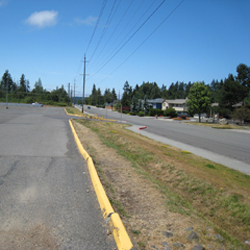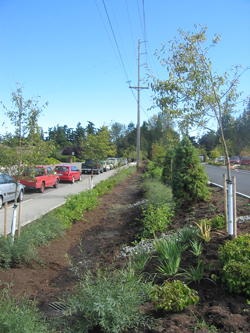|
Subscribe / Renew |
|
|
Contact Us |
|
| ► Subscribe to our Free Weekly Newsletter | |
| home | Welcome, sign in or click here to subscribe. | login |
Environment
| |
 |
February 17, 2011
Yes, parking lots can be green
O'Brien & Co.

Powers
|
When people think “parking lot” they think of cars and carbon emissions, but they don’t necessarily think “green.” What makes this type of infrastructure green?
O’Brien & Co. has had a chance to explore this issue recently with two pilot projects that are principally parking lots. The projects are for the Sustainable Sites Initiative program (SITES), the nation’s first rating system for sustainable landscape design, construction and maintenance. Turns out that the design and construction of parking spans all aspects of sustainability.
Adding to density
Should we be building parking in the first place?
Although some sustainability advocates vociferously condemn labeling any parking green, there are many examples where parking is part of an overall sustainable approach. Think of park-and-ride lots connecting to mass transit options, or converting surface lots into parking garages in a downtown area or on a campus to accommodate growth and add open space.
Urban multifamily projects with added parking often result in less parking available per person because of the density associated with them. They allow people that want or need cars for occasional use to move to settings where they can also walk, bike and use transit, minimizing total car trips.
A good example is Thornton Place in North Seattle, which turned a parking lot primarily used for holding car shows into apartments, condos, a movie theater, shops, restaurants and a park. Parking for the project was minimized by being next to the Northgate Transit Center, and an agreement to share parking between residents and commuters.
In discussions about the two SITES pilot projects — a new entry and renovated parking lot at Peninsula College in Port Angeles, and new parking at Olympic College in Bremerton — we asked Walter Schacht of Schacht Aslani Architects whether to look at just getting rid of the parking lots.
“Not every campus is well-served by mass transit or safe non-motorized routes, and that’s the case with both these colleges,” Schacht responded.
“Given that,” he said, “the challenge is how to design a parking lot that encourages the use of these alternatives to single-occupant vehicle use.”
Carpools will get priority parking at both college projects. Peninsula College will also have a multimodal station in the lot and a central drop-off for people traveling in vans.
“We also want to encourage alternatives to fossil fuel consumption,” Shacht said.
Olympia College, for example, will have accommodations for electric vehicle parking stations.
More green space
Parking lots can take the reduction of fossil fuel use one step further through efficient designs that reduce slow-speed driving and make use of fast, easy-to-use payment systems that reduce idle time.
Most new parking projects are installing LED lighting, including our SITES projects. A civic center parking garage in Santa Monica, Calif., is designed to offset all electrical use with wind and solar power.
Designers are also realizing that parking lots can contribute significantly to the aesthetic and pedestrian experience of a place. They present opportunities to provide open space and access to nature.
Mithun is in the schematic design phase of the 751 Marion St. parking garage in Seattle, where architect Phoebe Bogert described the opportunity to fill a hole in the neighborhood and enhance a designated green street.
“We are building the structure into the hill, eroding the edges and adding green space,” she said. “We are thinking of the project as being for the visitors to the neighborhood, addressing pedestrian pathways and seating to enjoy the views.”
Aesthetically, surface lots should look like landscaped areas with space for parking, according to Walter Schacht.
Functionally, he said, “these projects should address stormwater runoff quality and quantity issues as well as the heat island effect often associated with parking surfaces.”
O’Brien & Co.’s SITES pilot projects both address these functional needs.
Peninsula College is reducing the parking surface roughly 15 percent and introducing landscaped natural drainage areas, which treat 100 percent of the surface waters flowing into the Strait of Juan de Fuca.
The Olympic College parking lot project will infiltrate almost all stormwater on site through porous pavement and rain gardens. Both projects add significant trees and plantings that will reduce heat island effects.
More green strategies
The credits found in the pilot version of the SITES guidelines identify a number of other green building strategies that can be incorporated into parking and related infrastructure.
Rainwater can be harvested and stored for irrigation or used to create water features. Organic materials like plants and compost, and structural materials like concrete, asphalt and fill should come from local sources and possibly be salvaged materials.
Several parking projects have also found it possible to qualify for LEED certification through incorporation of a wide range of green measures.
The last studio of my masters in landscape architecture program involved designing temporary parking to offset parking lost during the construction of the University of Washington light-rail station. Although met with much dismay, the explorations done in that studio and the work of many respected local and national architects shows that parking projects should be looked at in the larger scheme, considering the appropriate role of the project in supporting a broad range of sustainability goals.
Elizabeth is principal and part owner of O’Brien & Co., a sustainability consulting firm.
Other Stories:
- Watch out for 'greenwashing' by service providers
- EcoDistricts: Sustainability that goes beyond buildings
- Rethinking the big-box store: Housing? Restaurants? Farms?
- Public housing gets a green makeover
- Sustainable developments reach Puget Sound shores
- Green is catching on in the real estate industry
- City's role evolving as green practices take hold
- Sustainable housing a natural fit for Bastyr
- 2 Seattle projects set ‘net-zero’ water goals
- Living Building project meant sweating the details




